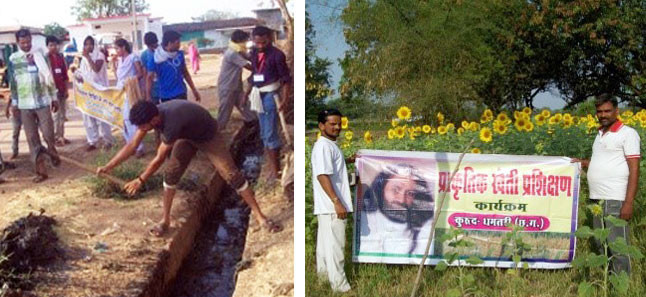Korba, Chhattisgarh: In Chhattisgarh, some 8,000 people died in the state in the past 18 months due to liquor consumption. But liquor brings in a lot of revenue for the government, which has been slow to act to this problem. In 2013-14, the state earned Rs 1,900 crore from liquor sales, which is Rs 900 crore more than the previous year.
“In 2013, 5 Art of Living teachers and 10 yuvacharyas visited different areas of Chhattisgarh and worked towards the development of 18 villages of Korba district. They conducted Nav Chetna Shibirs, Rural Happiness Program, and YLTP programs for the residents of these villages,” said Chandrasekhar Baghel.
Homemade liquor
In 2011, Chandrasekhar Baghel, an Art of Living faculty, started de-addiction work in the tribal villages of Korba district of Chhattisgarh. He trained the locals in Nav Chetna Shibir and conducted group satsangs. After he came across people under the influence of alcohol, he found out the residents prepared alcohol at home from ‘Mahua’, which is abundant in the area.
In Koi village, The Art of Living and NABARD volunteers formed a group of women who were already trained by The Art of Living and created awareness on the abuse of alcohol. The group also collected fines from people who made alcohol, and this gradually brought down the production.
Now people have stopped selling alcohol and Chandrasekhar has taught them organic farming, which is an alternative source of income. In Koi village, where there are more than 940 people and no one drinks. The villagers have started farming in small gardens, and they grow mango, papaya, cashew nut, millets and nuts with financial help from NABARD.
Gurudev visited Korba to meet the people. Since they had nothing to gift him, they made laddus from dried Mahua and other millets.
Rai Swaroop Sahu, a 31-year-old marketing executive with Bharti India Private Ltd. said, “I was mostly on field work. I used to leave my house at 8:30 a.m. and in the evening, instead of returning home, I used to sit with my friends and drink. I used to get irritated with the noise my children made and was so addicted that I could not sleep without drinking.”
Madan, another villager, said that after receiving organic farming training from Chandrashekhar, he dug a pit and started a nursery in the backyard of his house. “The Art of Living helped me to grow mango, papaya, pomegranate, cashew nuts, and also gave me the equipment for farming. They gave me organic seeds of onion, cauliflower and other vegetables and fruits. In the program, they trained us in farming techniques. Earlier, when I was an alcoholic, no one respected me. But now things are different.”
Women power
Ajay Shukla, an Art of Living teacher, said that the Koi village model has been implemented in other villages also. Yuvacharya Jitendra Nisad, a volunteer, brought all the women together and the five sarpanchs of Doma and Bade Karela village and started an agitation against the sale of liquor. Now, even though the shops exist, no one buys liquor from there.
Chandra Bhan said that after being trained under Art of Living’s organic farming program he started a nursery. “I grow papaya, mango, lemons, and other plants in it now. My land was infertile, so I was trained in cultivating mixed crops. By growing fruits and vegetables, my land has become fertile and my income has gone up now.”

